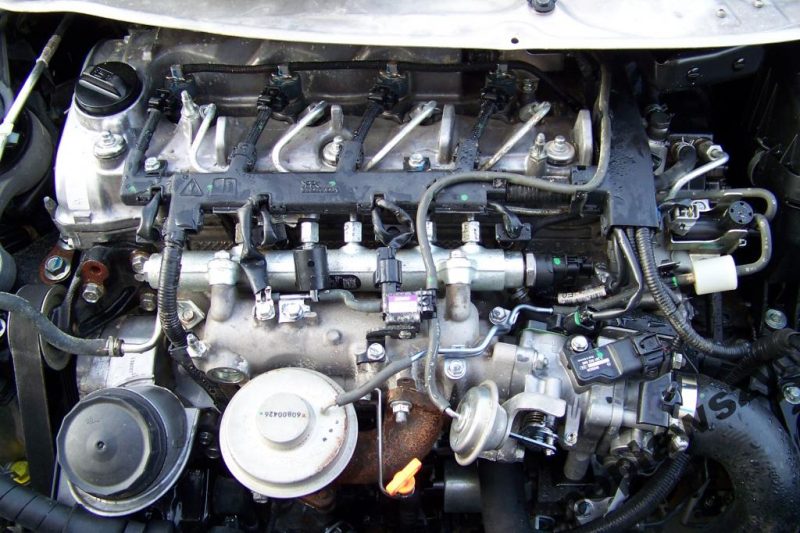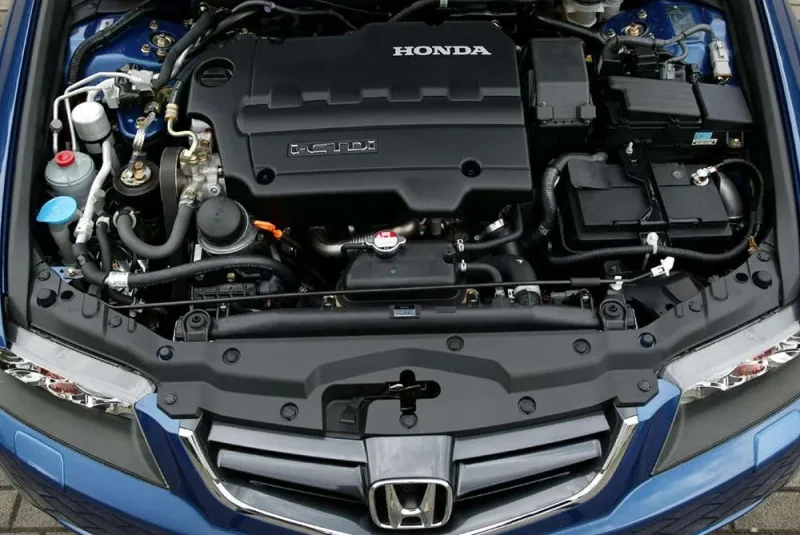The first power units running on diesel fuel were produced by Honda in 2003. Until then, the auto concern installed motors of other brands on its vehicles. The first diesels of the brand appeared in February 2003. Power units of N series had a volume of 1.6 and 2.2 liters. Production of the most powerful motor N22A1 was curtailed in 2004.
At the time of release, the power unit met all modern requirements and standards. Designers introduced such innovative approaches as an aluminum cylinder block, turbines with variable geometry. Common Rail fuel system manufactured by Bosch was used for injection. The engine was equipped with reliable injectors, 16-valve cylinder head, balancer shaft. With a volume of 2.2 liters, the engine developed 140 horsepower with a torque of 340 Nm. Similar motors were equipped with passenger vehicles for the European market.
Despite the lack of experience, the designers of Honda were able to produce a successful motor on diesel fuel. There are practically no complaints about the work of the engine. The main weak point is the dual-mass flywheel. To its reliability and cost there are questions. Another aspect in the operation of the motor is the need to use quality oil. Viscosity should be at the level of 0W-30. When filling another oil, there are difficulties with chain tensioning.
Technical characteristics
| Characteristics | Value |
|---|---|
| Modifications | N22A1, N22A2, N22A3 and others |
| Determined displacement | 2204 cm³ |
| Power system | Common Rail |
| Engine power | 140 hp |
| Torque | 340 Nm |
| Cylinder block | Aluminum, R4 |
| Cylinder head | Aluminum, 16 valves |
| Cylinder diameter | 85 mm |
| Piston stroke | 97.1 mm |
| Compression ratio | 16.7 |
| Engine Features | DOHC, intercooler |
| Hydrocompensators | No |
| Transmission timing | Chain |
| Fasoregulator | No |
| Turbocharger | Garrett GTA1752LV |
| What oil to use | 5.5 liters, 0W-30 |
| Fuel type | Diesel |
| Environmental class | Euro 4 |
| Example service life | 250,000 km |
| Engine weight | 175 kg |
Motor operation in cold weather

A lot of complaints cause the operation of this engine in frosts. When the temperature drops below -15 ° problems begin. If you fill up with not quite winter fuel, the heating of the fuel filter simply does not cope with its task and the Japanese diesel simply does not start. Besides, the fuel filter on Honda diesel is very delicate and it is better to change it every 7500 – 10000 km or before the winter season. Otherwise, there are problems with the pumpability of fuel through it.
Exhaust manifold cracking
For Honda 2.2 i-CTDi motors, one of the problems is related to wintertime operation. If the temperature on the street falls below -15 degrees, the power unit works unstably. In some cases, the Japanese diesel engine can not be started. The main reason is weak heating of the fuel filter.
Replacement of the fuel filter is recommended every 75-100 thousand kilometers of mileage. Similar measures are relevant at the beginning of the winter season. Problems with the pumping of fuel through the filter are considered a sore spot of such motors, so it is necessary to monitor the condition of the equipment constantly.
Problems with the exhaust manifold
With intensive use of Honda 2.2 i-CTDi cars, cracking of the exhaust manifold is characteristic. Such a defect is observed at a mileage of 150-200 thousand kilometers. The car manufacturer has recognized such a defect and increased the warranty on it up to 7 years. The defective unit is changed by the company free of charge.
Disadvantages of the IMRC valve and intake manifold
Structurally, the Honda engine is released in a set with a single flap, which is responsible for overlapping the common intake valves. Excessive build-up of soot and carbon black causes the damper to jam. For the same reason, the control solenoid valve may fail. Honda has recognized this assembly as defective. Valve replacement on power units manufactured before 2008 is performed free of charge.
Failure of the valve leads to vacuum leaks from the system. Accordingly, the damper operates with errors. For the driver, such defects are expressed in the loss of car power, jerks and grooves during acceleration. The diagnosis shows the error code P2004, if there are any problems with the air damper.
Pressure Sensor Malfunctions

In addition to problems with the throttle, there are other causes of a drop in motor power. First of all, there are issues with the absolute pressure sensor. Its contamination leads to a loss of motor power, weak response to pressing the gas pedal. On Honda engines, the MAP-indicator is located near the EGR valve, so it is heavily covered with soot and soot. The absolute pressure sensor malfunction can be recognized by errors P1069 or P0069. Another possible problem is cracks on the EGR valve tube. With such a defect, exhaust gases enter the system.
Turbocharger Performance Problems
Honda i-CTDi diesel engines are equipped with a Honeywell turbine. Structurally, the unit assumes liquid cooling of the bearings. The first models of the unit were not characterized by a long service life and durability.
Many owners turned to service because of the appearance of backlash on the turbine shaft. As a result, oil got into the intake and exhaust systems. After the modification of the turbine, such appeals were recorded much less often.
The peculiarities of the injectors
Another reliable node of the Honda 2.2 i-i-CTDi power unit is the injectors. On Japanese cars, these elements serve for a long time and without defects. Problems in operation can be associated with the burnout of copper washers. As a result, exhaust gases enter the injector channel. Timely replacement of washers neutralizes the problem.
The peculiarities of the timing chain
On Japanese cars Honda 2.2 i-CTDi of the first years of production, sometimes the stretching of the timing chain was recorded: the driver heard extraneous noise when the engine is running. At the same time, cases of chain breakage or links jumping were recorded very rarely.
Problems with the pulley and crankshaft oil seal
The reliability and durability of the damper pulley is beyond doubt. At the same time, this node is not eternal. The main problem is the cracking of rubber and the appearance of workings on metal parts. If the crankshaft oil seal leaks, the service life of the node is further reduced. Therefore, the owner must pay attention to the condition of the nodes. Other shortcomings in the operation of Honda 2.2 i-CTDi motors are practically not fixed.
